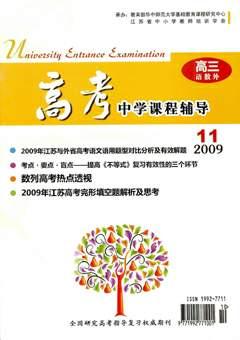模块10 Unit 1—Unit 2语法盘点
单祥富
一、关联词语
关联词语是复句中用来联结分句,标明分句与分句之间关系的词语。关联词语性质复杂,能在复句中起关联作用的主要有以下几类词语:
1.连词。连词是用来作关联词语的主要词类,但并非所有连词都能充当关联词语。
2.副词。某些副词可充当关联词语。起关联作用的副词仍旧保留原有的修饰作用。
3.有些短语也可以充当关联词语。
以下是句子之间常见的几种关联词语:
1) 表示顺序的关联词语:常用来表明一些想法或行为的顺序。常见的词语有:
first…,second…,third…;firstly…,secondly…,thirdly…;the former…,the latter…(前者……,后者……);to begin with=to start with (第一;首先);last but not least (最后但并不是最不重要的一点);finally=eventually=at last=in the end (最后,终于) 等等。
例:To begin with, we must consider the problem all-sidedly. 首先,我们必须全面地考虑这个问题。
Last but not least, we must thank our host for his hospitality. 最后但并非最不重要的一点是,我们得感谢主人的热情好客。
He tried various jobs and in the end became an accountant. 他尝试过各种各样的工作,最后当上了会计。
2) 表示因果的关联词语:常用来表示做某事的原因或结果。常见的词语有:
because of=due to=owing to=thanks to (因为,由于);as a result of=as a consequence of (作为……的结果);because (因为,由于);since,as (既然);as a result=as a consequence (因此);for (因为,由于);so,therefore,hence,in consequence (因此) 等等。
例:He didnt work hard. As a result he failed his exam. 他不用功, 结果考试不及格。
He was down with the flu, and therefore couldnt come to the party. 他患了流行性感冒,因此未能前来参加宴会。
She studied hard, and in consequence she passed the examination. 她努力学习,结果通过了考试。
3) 表示对照的关联词语:常用来引出前后意思相反的含义。常见的词语有:
on the one hand …, on the other hand…(一方面……,另一方面……);on the contrary (与此相反);however; nevertheless (不过,然而);in contrast (对比起来,相比之下);instead 等等。
例:On the one hand theyd love to have kids, but on the other hand, they dont want to give up their freedom. 一方面,他们想要孩子,但另一方面,他们又不想放弃自由自在的生活。
—Youre quite free now, I think. ——我想你现在一定很空。
—On the contrary, I have tons of things to do! ——正相反,我有一大堆事要做!
We cant act on your advice. Nevertheless, thank you for giving it. 我们不能照你的建议去办。不过承蒙您提出来,十分感谢。
4) 表示附加的关联词语:常用来引出附加信息。常见的词语有:
besides=whats more=in addition=moreover=furthermore=on top of sth. (此外);also (而且) ;above all (首先,最重要的是) 等等。
例:On top of this, according to the United Nations, hunger and disease malaria claim ten million lives every year. 除此之外,根据联合国的资料,饥饿和疟疾每年夺走一千万人的生命。
He is strong, brave and, above all, honest. 他强壮,勇敢,最重要的是他诚实。
二、段落基本要素
段落是由若干个彼此关联的句子构成的,通常用以表达一个中心思想或者从一个角度对文章的主题进行阐述。因此,段落不能是一组句子的任意堆砌,而是符合一定的模式,具有某些基本特征,遵循一定段落发展方法的。
结构完整的段落大多由三部分组成:
1.主题句
主题句是概括段落中心思想,反映作者写作意图的一个概括性的句子,是段落的核心所在。每一个段落都应该有一个主题句。
例如:
Young adults give many different reasons for moving to cities. Some are looking for a good job, and some seek excitement. The one thing that is clear, however, is that young people are speaking with one voice, ‘To the cities!
然而,并不是所有的段落都有主题句。有时,一个段落延续了前一段落的主题,同时也就延续前一段落的主题句。
例如:I saw by the clock of the city hall that it was past eleven; so I decided to go to the newspaper office immediately. Outside the editors door I stopped to make sure my papers were in the right order; I smoothed them out carefully, stuck them back in my pocket, and knocked. I could hear my heart thumping as I walked in.
主题句通常是段落的第一句,位于段首。
Whether we find a joke funny or not largely depends on where we have been brought up. The sense of humor is mysteriously brought up with national characteristics. A Frenchman, for instance, might find it hard to laugh at a Russian joke. In the same way, a Russian might fail to see anything amusing in a joke which would make an Englishman laugh to tears.
但是,有时为了吸引读者的注意力,常常先讲述一个有趣的事实,提出一个问题或引用一段引语之后,再引出主题句,位于段中或段尾。段首主题句开门见山,直接点明段落主题,有助于确定段落的主线,使各个支撑句围绕段落主题自然展开;段尾主题句具有结论作用,是对前面句子的归纳总结。
例:Passage 1
It is not uncommon nowadays to see rivers and lakes polluted by chemicals and covered with garbage. And the air we breathe is no longer fresh, but filled with poisonous exhausts coming from cars and factories. Besides, the loud noise from the construction sites greatly disturbs peoples life. Therefore, a very urgent thing that men should do right now is to protect the environment. We have only one earth to live on and we must keep it clean for ourselves as well as for our children and our grandchildren.
Passage 2
Alfred Nobel was the son of a bankrupt, but became a millionaire later. He was a scientist with a love of literature. And interestingly enough, he was an industrialist who managed to remain an idealist. He made a fortune but lived a simple life. A lover of mankind, he never had a wife or family to love him. So, it is not strange that many people think of this great Swedish inventor as a man of many countries.
2.支撑句
支撑句是用来支持或说明主题句的,是段落主题句的延伸和发展,起着辅助主题句、推展段落中心的作用,对主题句表达的中心思想或举例说明、或细致描写、或详细解释阐述和论证,使读者能够清晰地理解和信服地接受作者所表达的意思。
例:(1) The computer finds many applications in all fields. (2) Computers are now doing almost everything from diagnosing hospital patients to running nuclear power stations. (3) In any field where information is collected, processed, stored, and retrieved, computers are being used more and more. (4) Computers are also used as an aid to design planning. (5) For example, they can be used to predict faults in design as well as the cost of a design if one is planning to build a road.
在这个段落中,句 (1) 是主题句,提出计算机在所有领域都有应用的观点;句 (2)、(3)、(4) 和 (5) 是支撑句,都支持和说明句(1),具体说明计算机都在哪些领域应用。
3.结论句
结论句通常位于段落的末尾,在段落中也起着非常重要的作用,用以对全段内容进行总结、归纳或提出结论性的观点。结论句常和主题句相呼应,以不同的形式再现主题,并与扩展句相关联。但是并非任何段落都必须有结论句才算完整。有的段落,尤其是一些较短的段落中只有主题句没有结论句。
例:Across the USA, people are noticing the same thing: young people want to live in cities.

